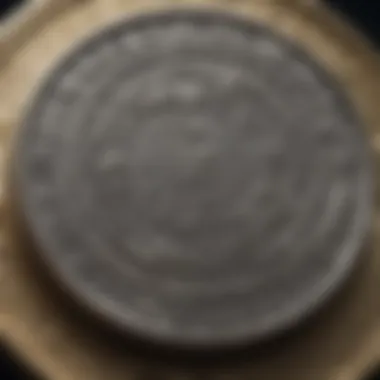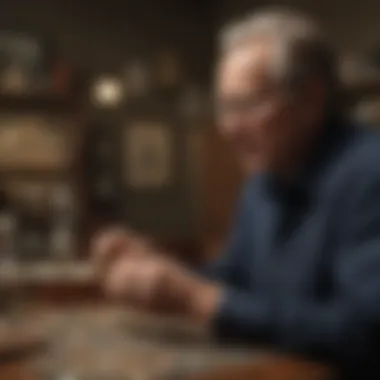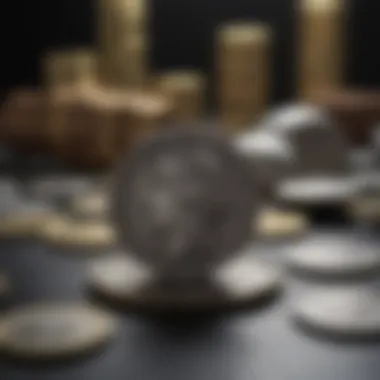Assessing the Value of Rare Coin Collections for Investors


Intro
The world of rare coins is often perceived as an exclusive realm reserved for elite collectors and seasoned investors. However, the truth is that anyone can delve into this fascinating field and potentially uncover remarkable treasures. Many enthusiasts embark on this journey not solely for monetary gain but for the rich history that each coin embodies. Understanding how to assess the value of these rare collections can not only validate the investment but also enhance the collector's overall experience.
Coin collecting transcends mere accumulation; it offers a unique narrative that weaves together history, artistry, and sometimes even personal stories. Each piece has its own journey, its own market life, influenced by myriad factors. This article aims to unravel those complexities, providing insight into the various elements that play a fundamental role in the valuation of rare coins.
Whether you're a novice sorting through granddad's attic or a seasoned pro at coin shows, knowing the ins and outs of valuation can lead to more informed decisions. Let’s jump into the key definitions that form the bedrock of this understanding.
Preamble to Rare Coin Collecting
The realm of rare coin collecting has morphed into a fascinating blend of historical intrigue and financial opportunity. For both novice collectors and seasoned investors, understanding the nuances of this hobby is crucial. When we think about collecting, it’s not just about the shiny metals; it’s about narratives—stories embedded in each coin that illuminate our past and reveal the society that minted them.
Delving into coin collecting isn’t merely an exercise in nostalgia or aesthetics; it presents genuine investment potential. Coins can be tangible assets that appreciate over time, influenced by factors such as rarity, condition, and historical significance. Collecting coins can feel a bit like embarking on a treasure hunt—a route littered with both pitfalls and prizes.
Additionally, the growing interest in collectible coins suggests a shift in how people view investments, blending market strategies with personal passions. Collectors now recognize that mastery in this arena isn’t achieved overnight. Instead, it demands diligence, research, and a keen eye for details that others might overlook. Recognizing the value of a coin isn't just about what it's worth at face value, but rather how it fits into the larger tapestry of its historical context and market trends.
In the following sections, we will peel back the layers on this complex topic. The intention is to establish thought-provoking insights that guide your journey in rare coin collecting.
Historical Perspective on Coin Collecting
Coin collecting isn’t a modern pursuit; it's steeped in centuries of history. Ever since humans began trading and using money, coins have captured the imagination. From ancient Roman sestertii to gold doubloons of the Age of Discovery, the numismatic story is rich and varied. Historically, collectors often focused on coins that signified power or wealth, showcasing the glamor of different eras.
Anecdotal evidence suggests that some of the earliest collectors were not financial investors but individuals interested in the aesthetic and artistic qualities of coins, sometimes driven by historical or familial ties. Over time, though, this changed dramatically. During the Renaissance, collectors began treating coins as historical artifacts, which later transitioned into viewing them as investments.
Collecting has historically served multiple purposes—cultural appreciation, academic research, and economic planning. Today, collectors benefit from an array of resources and communities, both online and offline, which help to foster shared knowledge and appreciation of coinage.
The Upsurge in Collectible Coins
In recent years, there’s been a noticeable uptick in interest around collectible coins. The reasons are many, but perhaps the strongest motivator is the blending of passion with investment. With economic fluctuations and uncertainties in traditional investing avenues, many individuals are exploring tangible assets like rare coins as a hedge against inflation.
Popularity is further fueled by social media platforms and online forums where enthusiasts share information, experiences, and even photographs of their prized collections. The digitization of market data and price guides has made it easier for collectors to keep track of their assets, compare values, and even sell or trade coins.
Consequently, the surge can also be attributed to the rise of numismatic education. More collectors today are actively seeking knowledge about the history, authenticity, and valuation of coins than ever before. This leads to informed purchases and ultimately contributes to a more robust market. The newfound interest is both a boon and a challenge—while it invites a wider pool of collectors, it also elevates the competition for rare finds.
Understanding Coin Value
Understanding the nuances of coin value plays a pivotal role in both collecting and investing in rare coins. When it comes to numismatics, deciphering value isn’t just about the monetary figure stamped on a price tag. It involves various intricacies that cater to collectors’ preferences, market fluctuations, and historical significance.
A well-rounded grasp of coin value helps enthusiasts make informed decisions. Without this knowledge, one might pay a premium for a coin that’s not as rare as they believe or perhaps pass on a hidden gem that could appreciate over time. Thus, comprehending the elements that determine value isn’t merely beneficial; it’s essential for anyone dabbling in the world of coin collection.
Defining the Concept of Value in Numismatics
In numismatics, value is perhaps the most crucial concept one must understand. It's a composite of several factors rather than a straightforward price tag. One can think of value as a spectrum, with various dimensions that contribute to a coin’s overall worth.
From rarity to demand, each aspect plays its part. It’s crucial to differentiate between factors like numismatic value—reflecting a coin's desirability among collectors—and intrinsic value, highlighting its metal composition and weight. Understanding this multifaceted nature of value can lead to better purchasing decisions.
Furthermore, defining value in numismatics can often feel like navigating uncharted waters. The market is rife with ebbs and flows, creating opportunities and pitfalls alike. With some coins appreciating in value due to historical discovery or changing trends, understanding these dynamics is key to becoming a seasoned collector.
Intrinsic versus Extrinsic Value
When evaluating rare coins, distinguishing between intrinsic and extrinsic value is vital.
Intrinsic value pertains to the coin’s inherent qualities, such as its metal content. For instance, a gold coin is worth more than just its face value because of the gold it contains. This type of value remains relatively constant, even if the coin’s numismatic appeal fluctuates.
On the other hand, extrinsic value refers to the external factors that might influence a coin's worth, like collector demand and market trends. A seemingly mundane coin from one era can skyrocket in price if a famous collector expresses interest. Moreover, the historical context surrounding a coin can drastically sway its market appeal.
To illustrate this point, consider an ancient Roman coin made from silver. Its intrinsic value is tied closely to the current silver market. However, if a well-documented provenance emerges, enhancing its story, the extrinsic value may see a massive uptick, far surpassing its intrinsic worth. Understanding these two spectrums will deepen your appreciation for coins as tangible assets.
"Value is not a fixed point but a dynamic interplay of intrinsic qualities and external perceptions."


Delving into the layers of coin value equips collectors with the knowledge needed to navigate the field effectively, ensuring that they don’t just follow market trends but also appreciate each coin's unique story.
Key Factors Influencing Value
Understanding the worth of rare coins extends beyond mere surface observation; it involves a nuanced evaluation of several critical aspects. Each factor plays a unique role that can significantly shift the value pendulum in either direction, thus comprising the core of any serious collector's appraisal process. Let’s take a closer look at the elements that mold the valuation of these numismatic treasures.
Rarity and Scarcity
When it comes to coins, rarity is often the bedrock of value. The fewer examples exist, the more sought after they become. Consider a coin from a small minting run; its scarcity instantly amplifies its desirability among collectors. For instance, the 1913 Liberty Head nickel was minted in such a limited quantity that it has become a holy grail for enthusiasts and carries a staggering price tag that can reach millions at auction.
Scarcity can derive not only from limited mintage but also from historical events that might have led to destruction or loss of certain coins. A coin lost during the Second World War can now be worth a fortune, despite being far less known than more commonly circulated pieces. Rare coins are a bit like vintage wines; their value can appreciate over time.
Condition and Grading Systems
Condition plays an equally significant role in determining a coin's value. Coins graded as 'Mint State' (MS) and 'Proof' stand a much better chance of fetching high prices compared to those showing wear and tear. Numismatists use widely recognized grading scales, like the Sheldon Scale, to evaluate coins from 1 to 70. A coin in perfect condition is rare and demands a premium.
For those new to the collecting scene, it’s vital to familiarize yourself with common grading terms such as "Fine" or "Very Fine". A well-preserved example can command a price several times higher than a similarly rare but poorly maintained sample. Keyword alert: condition! On platforms like Reddit, you’ll find discussions about best practices in maintaining condition to prevent losing value.
Historical Significance and Provenance
Each coin tells a story, and its historical context can elevate its appraisal. A coin associated with a pivotal moment in history, such as a commemorative coin from the Apollo 11 mission, often garners more attention and value than an ordinary piece. Provenance—the history of ownership—is also crucial. If a coin has passed through the hands of notable collectors or has been featured in important auctions, its prestige and allure are often worth extra bucks.
In the same way that a painting’s previous owners can enhance its value, a rare coin's backstory can intrigue potential buyers. Collectors often seek out the lineage of a coin, and being able to present an impressive provenance could make all the difference in negotiations.
Market Demand and Trends
Understanding market trends can serve as a compass for potential investors. Prices can fluctuate greatly based on buyer interest and market conditions. There could be seasonal trends, like increased sales around collectible fairs or during holiday seasons when more casual buyers enter the market.
Moreover, economic factors could drastically shift the supply and demand balance. When the economy experiences upheaval, tangible assets like rare coins often become more attractive to investors, pushing demand—and thus prices—upwards.
In summary, grasping these key factors is not merely academic; they form the practical framework for gauging coin value. Collectors and investors need to keep their ears to the ground and stay informed about shifts within the market landscape.
"The essence of coin collecting is the delicate balance between history, art, and economics."
Staying proactive and informed can safeguard against unfavorable investing decisions and ensure that every piece in a collection reflects not just monetary value but also the rich tapestry of history.
Methods for Valuing Rare Coins
When it comes to determining the worth of rare coins, understanding the methods for valuing them is crucial. The world of numismatics can be as intricate as the coins themselves, and pinpointing their true value requires a thoughtful approach. This segment will dissect various methods that collectors and investors can utilize to appraise their coins, each with its own set of advantages and considerations. By adopting the right techniques, one can gain a clearer perspective on the potential investment value, making informed decisions rather than relying on gut feelings.
Professional Appraisal Services
Seeking out professional appraisal services can be one of the most reliable ways to ascertain the value of a rare coin collection. These professionals, often seasoned in numismatic circles, bring a wealth of expertise that is hard to match. They evaluate coins based not just on their immediate market value, but also on historical context and specific characteristics unique to each piece.
Here are some points to consider:
- Expertise: Appraisers typically have credentials and background in numismatics, providing an insight that can illuminate the value of lesser-known coins.
- Comprehensive Analysis: They often conduct thorough evaluations involving factors like rarity, condition, and provenance, rather than just looking at current market trends.
- Formal Documentation: A professional appraisal usually comes with a detailed report that can serve well in future transactions or if you need insurance evaluations.
While using professionals is beneficial, it can also incur costs, which is something to examine closely against the potential gains from a more accurate valuation.
Using Price Guides and Catalogs
For those who prefer a hands-on approach in valuing their rare coins, price guides and catalogs can be invaluable tools in one's numismatic toolbox. These resources provide a baseline for assessment and can be found in both print and online formats.
Price guides typically offer:
- Market Comparisons: They give current market prices along with historical data, which can help gauge trends over time.
- Detailing Noteworthy Features: Many catalogs outline important characteristics of coins—like mint marks and errors—that can significantly impact value.
- User-Friendly Formats: Price guides are accessible, allowing collectors to familiarize themselves with the intricacies of their coins without needing expert intervention.
However, relying solely on price guides may not be foolproof. Prices can fluctuate based on market demands, and some pieces may not be fully represented in these resources.
Auctions and Market Sales Analysis


Analysing auctions and market sales can provide real-time insight into how coins are valued. Observing auction results allows one to see what collectors are willing to pay for similar coins, creating a snapshot of market demand.
Key aspects of this method include:
- Real-World Data: Auction results represent actual transactions rather than theoretical prices, giving a truer picture of worth.
- Trends Over Time: Keeping track of auction listings can illustrate shifts in collector interest or market conditions over time.
- Networking Opportunities: Engaging in auctions allows collectors to connect with other enthusiasts and industry experts, expanding their overall knowledge base.
A word of caution, though: auction results can vary widely depending on the venue, regional interest, and even the time of year, so one must consider a broader perspective for the most accurate assessments.
Investing in Rare Coins: Strategies and Considerations
Investing in rare coins can be like navigating a winding river. It’s not merely throwing your cash around; it requires careful thinking and strategic planning. Knowing how to wade through the waters of coin collecting not only maximizes your portfolio’s potential but also contributes to a richer understanding of this fascinating field. In this section, we'll delve into some key aspects that collectors—whether seasoned or just dipping their toes—should consider when investing in rare coins.
Diversifying a Coin Collection
Diversification in coin collecting is akin to not putting all your eggs in one basket. Investing exclusively in a single type or era of coins can lead to pitfalls. The market for rare coins fluctuates and can be influenced by trends that may shift unexpectedly. So, what does diversification look like?
- Type: Look into a variety of coin types, such as gold, silver, copper, and perhaps even modern coins.
- Era: Collect coins from different historic periods. Victorian coins may be all the rage today, but who knows what the next auction might bring?
- Geographical Locations: Consider coins from various countries. A Roman denarius might intrigue you just as much as a U.S. mint state coin.
Having a broad collection can cushion your investment against market volatility. A buyer's interest can wax and wane, and with a menagerie of coins, you’re less susceptible to sudden drops in demand for one particular type. This strategy not only guards against losses but can also make your collection more appealing to a wider audience.
Avoiding Common Pitfalls in Coin Investment
Just like a coin has two sides, investing also has its risks. The realm of rare coin investment includes some common pitfalls that can catch even the most experienced investors off guard. Here’s how to sidestep those traps:
- Overvaluation: Be cautious of overpaying for coins, particularly if they are labeled as ‘rare’ by sellers. Research comparable sales or get a professional appraisal before making a purchase. This can save you a substantial chunk of change in the long run.
- Ignoring Liquidation Potential: When choosing coins to invest in, consider how easily they can be sold in the future. Some rare coins may have a small niche market and could be tough to flip later.
- Neglecting Preservation: Don’t let ignorance of proper storage sneek up on you. Poor handling and environmental conditions can wreak havoc on a coin’s value.
- Falling for Trends: The danger of riding a fad wave can be tempting, yet investing based solely on trends can yield regrettable outcomes. The moment you decide to invest, do your due diligence.
Adopting these considerations can help investors forge a path toward a more sensible and rewarding experience in the world of rare coins. Remember to evaluate carefully and plan strategically.
"A wise investor knows that patience and homework pay off in the long run."
In closing, recognizing the importance of diversifying your collection and being aware of common pitfalls can enhance your investment approach. This knowledge arms you with the tools to navigate the rare coin market, paving the way for both enjoyment and financial returns.
The Role of Marketplaces in Coin Valuation
Understanding the influence of marketplaces on coin valuation is crucial for anyone serious about coin collecting and investing. Marketplaces are where the rubber meets the road when it comes to determining the fair market value of any rare coin. The dynamics of these platforms—be it online or traditional auction houses—can greatly affect how coins are appraised and sold.
One of the primary benefits of engaging with a variety of marketplaces is the exposure it gives to collectors. By exploring different avenues, investors can discover trends, assess the competition, and gauge demand more effectively. In this space, information is king; hence, being present in multiple marketplaces can arm a collector with insights they might not get from a singular focus.
Not all marketplaces provide the same level of transparency or reliability, making it essential to understand what you're getting into. You’ll find that certain platforms cater more to serious investors, while others may be more casual. This distinction can affect the quality of their customer base, which in turn impacts the value of the coins being traded. In this guide, we’ll delve deeper into the two main types of marketplaces: online platforms and traditional auctions, highlighting their unique roles and integration into the valuation process.
Online Platforms for Buying and Selling
Online platforms are a game changer in the world of rare coin collecting. With the rise of e-commerce, collectors now have access to a global market, allowing them to acquire coins that once may have only been available in localized shops or shows. Examples include websites like eBay, Heritage Auctions, and even dedicated numismatic sites such as GreatCollections.
Using these online avenues offers multiple advantages:
- Accessibility: You can browse thousands of listings from the comfort of your couch.
- Real-time bidding: Live auctions allow for immediate pricing adjustments based on current market interest.
- Price comparisons: Online platforms enable collectors to see multiple sales histories for similar coins, helping refine their understanding of value.
However, there are caveats. The anonymity of internet transactions means that due diligence is paramount. Unscrupulous sellers and listings can mislead buyers, leading to uninformed purchases. It’s advisable that investors verify seller credentials and cross-reference any significant transaction with other platforms or trusted sources.
"The digital age has turned the coin market into a virtual goldmine, but tread carefully among the treasure to find what is genuinely valuable."
Traditional Auctions and Their Impact
On the other hand, traditional auctions still hold a significant spot in the world of coin valuation. Institutions like Sotheby's and Christie’s have established reputations that speak volumes about the trust they engrain into transactions. Participating in these auctions can be a thrilling experience where the atmosphere is electric, and the stakes can be high.
Engaging in traditional auctions offers several benefits, including:
- Expertise: Auction houses often employ numismatic experts who can provide valuable insights and appraisals.
- Verification: The credibility of these institutions adds a layer of reassurance to buyers and sellers alike.
- Competition: The auction format can drive prices higher, depending on the demand among bidders for specific pieces.


That said, there are downsides to consider, too. Traditional auctions usually involve fees that might eat into potential profits. Moreover, the pace of bidding can be intimidating for new collectors who may not be familiar with the process. It's essential to prepare ahead of time, understand the item’s value, and have a clear set budget in mind.
With both online and traditional marketplaces, it’s evident that understanding these platforms' roles in coin valuation impacts the collector or investor's journey. By leveraging the strengths of each, collectors can navigate the complex world of rare coin collecting with a more informed perspective.
Long-Term Care and Management of Coin Collections
Long-term care and management of coin collections is crucial for both collectors and investors. The value of rare coins can diminish significantly if they are not properly maintained. Ensuring the longevity of your collection not only preserves its market worth but also enhances your enjoyment as a collector. A well-managed collection can also make the process of evaluating and selling coins much smoother.
Proper Storage Techniques
The way you store your coins can greatly impact their condition. Coins should be kept in a stable environment where temperature and humidity are controlled to prevent tarnishing and corrosion. Here are some effective storage methods:
- Use Coin Holders: Instead of placing coins in albums or directly handling them, use holders made from inert materials such as polyethylene or Mylar. These prevent scratches and protect from environmental hazards.
- Climate Control: Store coins in a cool, dry place away from direct sunlight. Basements and attics can be detrimental because of fluctuating temperatures and humidity levels.
- Avoid Cleaning: Resist the urge to clean coins. Cleaning can often result in scratches and loss of value. If you must clean them, consult a professional first.
"The best coin collector is not just one who knows the value of coins, but also how to protect their integrity over time."
Insurance and Protection Options
When it comes to rare coin collections, insurance is an aspect that should never be overlooked. Due to the potential high value of coin collections, ensuring they are properly insured offers peace of mind. Here are some insurance options and protective measures to consider:
- Specialty Insurance Policies: Most typical homeowner's insurance policies do not cover collectibles adequately. Look for companies that offer specialized coin insurance, which provides better protection against theft, loss, or damage.
- Inventory Documentation: Maintain a detailed inventory of your collection, including photographs, purchase prices, and current valuations. This documentation can be invaluable in case of loss and also aids in determining insurance coverage needs.
- Regular Appraisals: As coin values fluctuate, it's wise to have your collection appraised periodically. This ensures that your insurance coverage matches the current market value of your collection.
By implementing these strategies for long-term care and management, you can ensure that your rare coin collection remains in great condition, preserving its value for years to come. Paying attention to storage techniques and considering proper insurance is not just a wise practice; it's essential for any serious collector.
Market Outlook for Rare Coins
Understanding the market outlook for rare coins is crucial for anyone involved in numismatics, whether you're a rooking collector or a seasoned investor. As the landscape of coin collecting continues to evolve, awareness of current trends and future predictions can significantly influence investment decisions. This section aims to shed light on the elements shaping the future of rare coin valuations.
Current Trends in Coin Collecting
The world of coin collecting is hardly static; it evolves with shifts in societal interests and technological advances. Several pivotal trends are making waves in how collectors and investors approach the hobby today.
- Digital Transformation: Technology is playing a monumental role. From online auctions to virtual marketplaces, collectors can now transact coins from the comfort of their homes. Platforms such as eBay and Facebook groups have become popular hunting grounds for both novice and expert collectors.
- Increased Popularity: Interest in rare coins has surged. Economic uncertainties, like inflation or fluctuating stock markets, have driven collectors towards tangible assets. Many see rare coins as a hedge against economic instability.
- Community Engagement: Collectors are leaning more towards community-driven initiatives. Memberships in organizations and online forums, such as Reddit communities, allow enthusiasts to exchange insights and tips, enhancing the value of knowledge over mere possessions.
With these trends in mind, collectors should remain agile, adjusting their strategies based on changes in the marketplace.
Predictions for Future Value Fluctuations
Looking ahead, several factors are likely to influence the value of rare coins in the years to come. Investors must consider these aspects to navigate the waters effectively.
- Demographic Shifts: As more millennials and Gen Z individuals show interest in collecting, demand for coins perceived as trends may rise. Coins that resonate with younger collectors—including those with historical cultural significance—might see a boost in value.
- Economic Factors: Macroeconomic conditions, such as inflation and interest rates, typically dictate how much collectors are willing to pay. A dipping economy can prompt an increased interest in investment-grade coins while potentially devaluing more common collectibles.
- Market Saturation: A saturated market could lead to instability in prices. If too many coins of a certain type flood the market, values may plummet; it’s essential to distinguish between collectibles with lasting appeal versus those that are merely fads.
"Understanding the nuances of market trends is vital for any serious investor in rare coins. Foresight can make all the difference in navigating the peaks and valleys of coin value."
As we forge ahead in the realm of rare coins, it’s clear that an informed approach is your best ally. By remaining keenly aware of these trends and predictions, collectors can strategize, ensuring their investments are sound and attuned to the rhythms of the market.
The End
Understanding the valuation of rare coin collections is not just a passing interest for avid collectors; it forms the very foundation of successful collecting and investing strategies. Navigating this intricate landscape demands a blend of knowledge, research, and discernment. The core of this article emphasizes that accurate valuation goes beyond superficial appraisals; it requires an in-depth look at various elements that contribute to a coin’s worth.
Summing Up the Importance of Accurate Valuation
Accurate valuation serves several critical purposes. First, it aids collectors in making informed purchasing decisions. When you know what a coin is worth, you can negotiate effectively and avoid overpaying. The second layer is related to investment potential. Many would-be investors conflate market trends with actual value, but a keen understanding of valuation helps one to see past fleeting fads. For instance, a coin may spike in price due to a sudden interest, but its true value might take time to reveal itself—much like a fine wine needing to breathe.
Furthermore, accurate valuation protects against scams. In an age filled with quick transactions, where misinformation can spread like wildfire, being well-informed arms collectors against falling prey to dishonest sellers. Having a concrete grasp of value enables one to spot a scam from a mile away.
"Knowing the true worth of your collection is like having a compass in the wilderness. It guides you to safety and success."
Encouragement for Potential Investors
For those considering an entry into the rare coin market, the landscape can seem daunting at first. However, the potential rewards—both personal and financial—are significant. Begin by doing your homework. Familiarize yourself with key terminology and methods of valuation. This won't just prepare you for acquisitions; it'll help you feel more confident in discussions with seasoned collectors.
Start small. Investing in lesser-known coins may help mitigate risk while you gather experience. As you build knowledge, your instincts will sharpen, making larger investments more enticing and feasible.
Lastly, remember that the coin market is not just about profits and losses. Each coin has a story, perhaps tied to historical events or significant figures. This combination of passion and profit can make rare coin collecting a deeply satisfying endeavor. So, while the tangible aspect of money is important, do not overlook the joy that these pieces can bring.
In summary, the journey into rare coin valuation and investment is layered with complexity, but the potential to yield both knowledge and wealth makes it an attractive pursuit for enthusiasts and investors alike.







